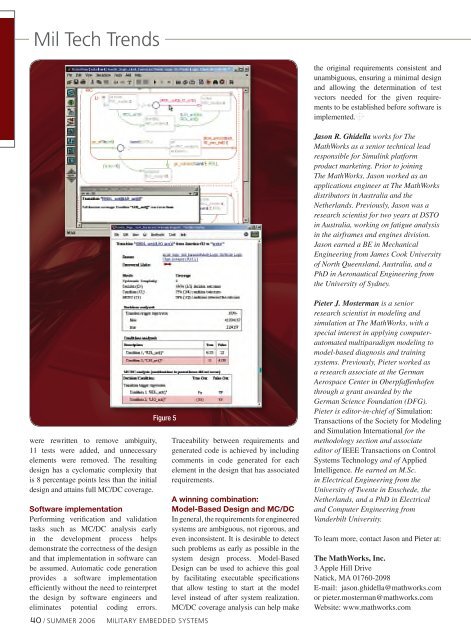Military Embedded Systems Summer 2006
Military Embedded Systems Summer 2006
Military Embedded Systems Summer 2006
You also want an ePaper? Increase the reach of your titles
YUMPU automatically turns print PDFs into web optimized ePapers that Google loves.
Mil Tech Trends<br />
the original requirements consistent and<br />
unambiguous, ensuring a minimal design<br />
and allowing the determination of test<br />
vectors needed for the given requirements<br />
to be established before software is<br />
implemented.<br />
Jason R. Ghidella works for The<br />
MathWorks as a senior technical lead<br />
responsible for Simulink platform<br />
product marketing. Prior to joining<br />
The MathWorks, Jason worked as an<br />
applications engineer at The MathWorks<br />
distributors in Australia and the<br />
Netherlands. Previously, Jason was a<br />
research scientist for two years at DSTO<br />
in Australia, working on fatigue analysis<br />
in the airframes and engines division.<br />
Jason earned a BE in Mechanical<br />
Engineering from James Cook University<br />
of North Queensland, Australia, and a<br />
PhD in Aeronautical Engineering from<br />
the University of Sydney.<br />
were rewritten to remove ambiguity,<br />
11 tests were added, and unnecessary<br />
elements were removed. The resulting<br />
design has a cyclomatic complexity that<br />
is 8 percentage points less than the initial<br />
design and attains full MC/DC coverage.<br />
Software implementation<br />
Performing verification and validation<br />
tasks such as MC/DC analysis early<br />
in the development process helps<br />
demonstrate the correctness of the design<br />
and that implementation in software can<br />
be assumed. Automatic code generation<br />
provides a software implementation<br />
efficiently without the need to reinterpret<br />
the design by software engineers and<br />
eliminates potential coding errors.<br />
Figure 5<br />
40 / SUMMER <strong>2006</strong> MILITARY EMBEDDED SYSTEMS<br />
Traceability between requirements and<br />
generated code is achieved by including<br />
comments in code generated for each<br />
element in the design that has associated<br />
requirements.<br />
A winning combination:<br />
Model-Based Design and MC/DC<br />
In general, the requirements for engineered<br />
systems are ambiguous, not rigorous, and<br />
even inconsistent. It is desirable to detect<br />
such problems as early as possible in the<br />
system design process. Model-Based<br />
Design can be used to achieve this goal<br />
by facilitating executable specifications<br />
that allow testing to start at the model<br />
level instead of after system realization.<br />
MC/DC coverage analysis can help make<br />
Pieter J. Mosterman is a senior<br />
research scientist in modeling and<br />
simulation at The MathWorks, with a<br />
special interest in applying computerautomated<br />
multiparadigm modeling to<br />
model-based diagnosis and training<br />
systems. Previously, Pieter worked as<br />
a research associate at the German<br />
Aerospace Center in Oberpfaffenhofen<br />
through a grant awarded by the<br />
German Science Foundation (DFG).<br />
Pieter is editor-in-chief of Simulation:<br />
Transactions of the Society for Modeling<br />
and Simulation International for the<br />
methodology section and associate<br />
editor of IEEE Transactions on Control<br />
<strong>Systems</strong> Technology and of Applied<br />
Intelligence. He earned an M.Sc.<br />
in Electrical Engineering from the<br />
University of Twente in Enschede, the<br />
Netherlands, and a PhD in Electrical<br />
and Computer Engineering from<br />
Vanderbilt University.<br />
To learn more, contact Jason and Pieter at:<br />
The MathWorks, Inc.<br />
3 Apple Hill Drive<br />
Natick, MA 01760-2098<br />
E-mail: jason.ghidella@mathworks.com<br />
or pieter.mosterman@mathworks.com<br />
Website: www.mathworks.com
















